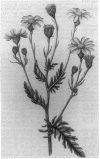Abstract
BACKGROUND--In animal models of circulatory shock and heart failure concentrations of the endogenous opioid peptide beta endorphin are raised and opioid receptor blockade improves haemodynamic variables and survival. This study was performed to identify whether acute myocardial ischaemia provokes the release of beta endorphin in humans. METHODS--Observational study in a university cardiology centre. Serial measurements of beta endorphin made by specific radioimmunoassay were correlated with other clinical and neuroendocrine variables that were measured prospectively. Fifty five patients with acute myocardial ischaemia and 26 patients undergoing elective coronary angioplasty of the left anterior descending coronary artery were studied. RESULTS--beta endorphin concentrations were raised above the upper limit of normal in 31/42 (74%) patients with confirmed myocardial infarction, 3/13 (23%) patients with unstable angina, and 10/24 (42%) patients after coronary angioplasty. There was no evidence of myocardial release of beta endorphin. There were significant positive correlations between beta endorphin and the concentrations of adrenocorticotrophic hormone, cortisol, and arginine vasopressin. In patients with acute myocardial ischaemia there was a significant positive correlation between the peak concentrations of creatine kinase and beta endorphin but no correlation with visual analogue scores of the intensity of chest pain. The highest beta endorphin concentrations were seen in patients whose clinical course was complicated by the development of heart failure. CONCLUSIONS--beta endorphin release is a component of the neuroendocrine activation associated with myocardial ischaemia/infarction.
Full text
PDF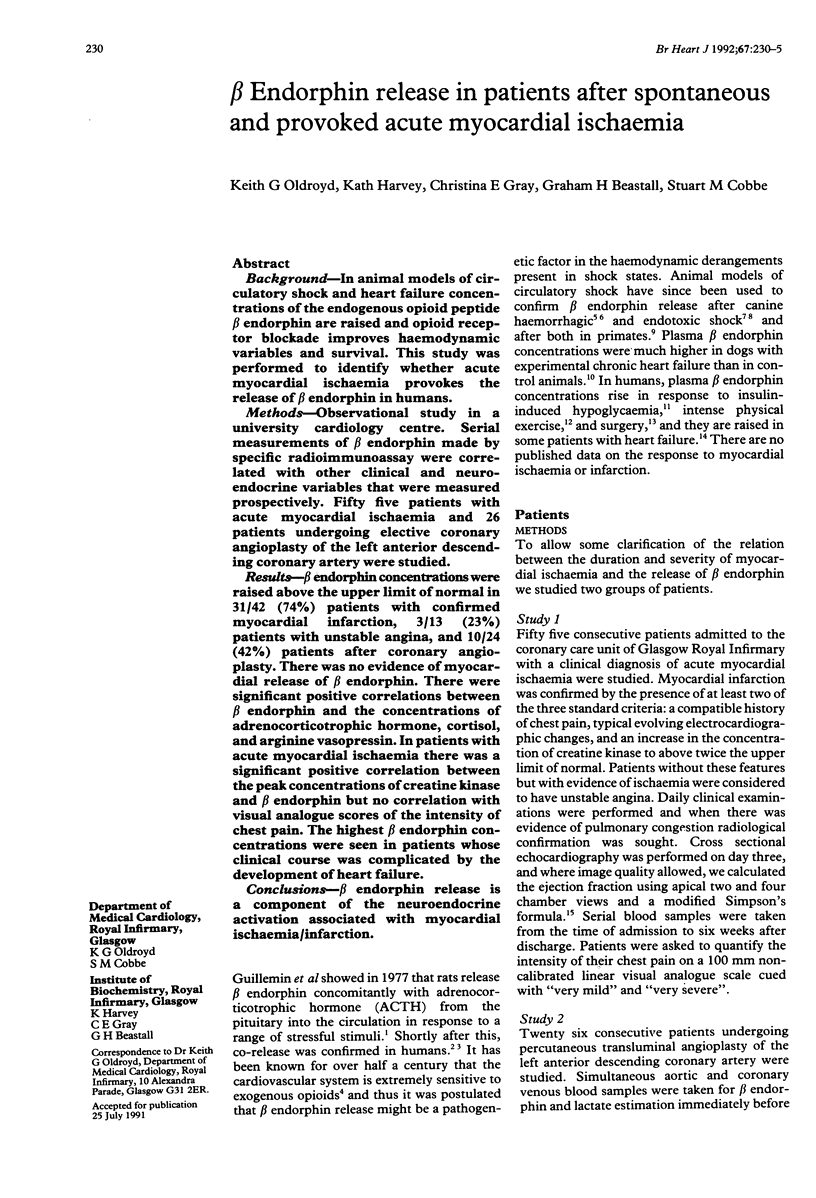
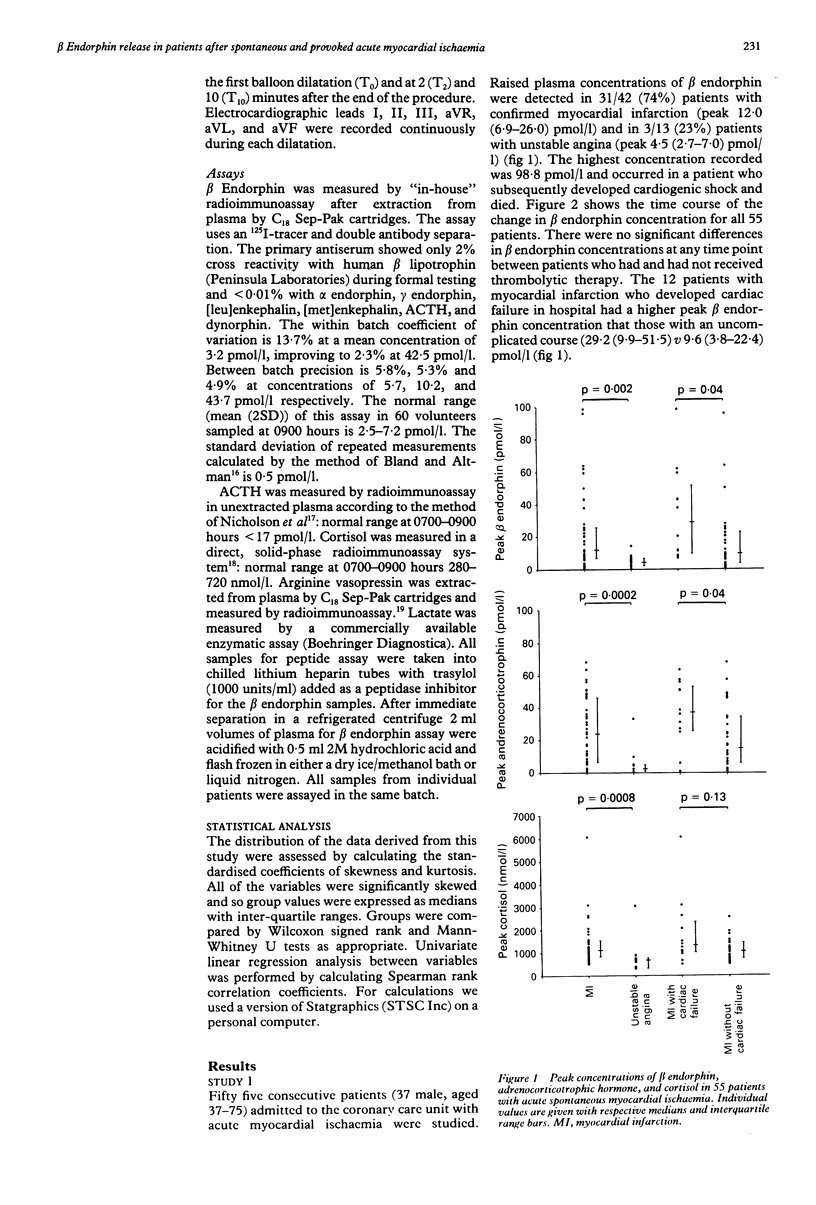

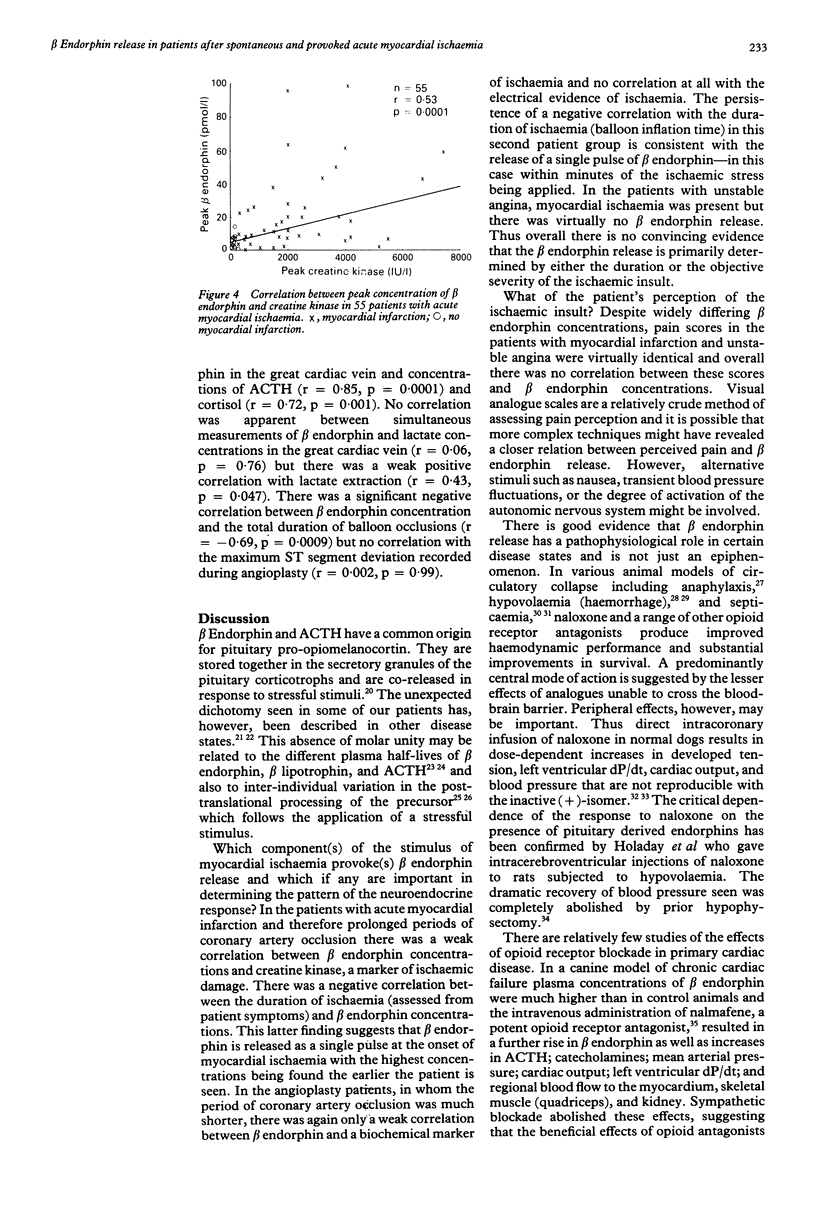

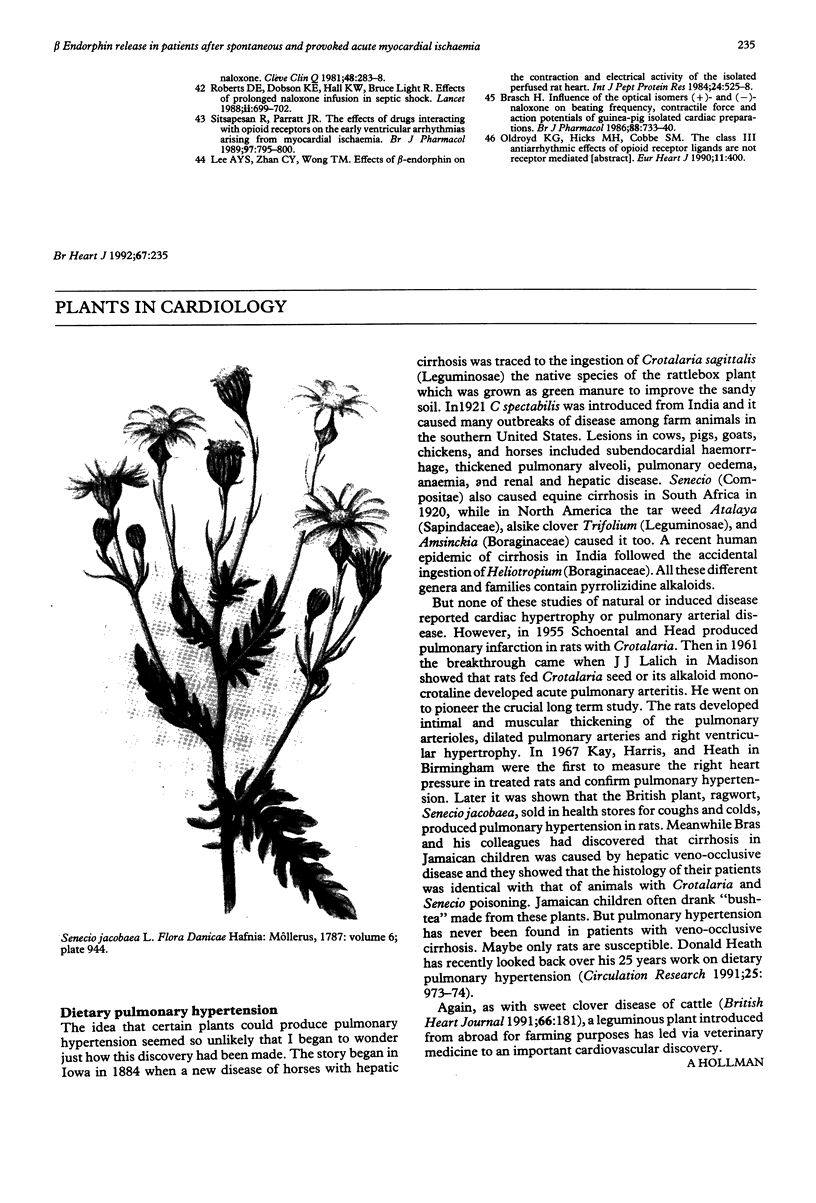
Images in this article
Selected References
These references are in PubMed. This may not be the complete list of references from this article.
- Amir S. Opiate antagonists improve survival in anaphylactic shock. Eur J Pharmacol. 1982 May 7;80(1):161–162. doi: 10.1016/0014-2999(82)90194-7. [DOI] [PubMed] [Google Scholar]
- Aronin N., Wiesen M., Liotta A. S., Schussler G. C., Krieger D. T. Comparative metabolic clearance rates of beta-endorphin and beta-lipotropin in humans. Life Sci. 1981 Sep 21;29(12):1265–1269. doi: 10.1016/0024-3205(81)90232-0. [DOI] [PubMed] [Google Scholar]
- Bland J. M., Altman D. G. Statistical methods for assessing agreement between two methods of clinical measurement. Lancet. 1986 Feb 8;1(8476):307–310. [PubMed] [Google Scholar]
- Brasch H. Influence of the optical isomers (+)- and (-)-naloxone on beating frequency, contractile force and action potentials of guinea-pig isolated cardiac preparations. Br J Pharmacol. 1986 Aug;88(4):733–740. doi: 10.1111/j.1476-5381.1986.tb16245.x. [DOI] [PMC free article] [PubMed] [Google Scholar]
- Brückner U. B., Lang R. E., Ganten D. Release of opioid peptides in canine hemorrhagic hypotension: effects of naloxone. Res Exp Med (Berl) 1984;184(3):171–178. doi: 10.1007/BF01852391. [DOI] [PubMed] [Google Scholar]
- Caffrey J. L., Gaugl J. F., Jones C. E. Local endogenous opiate activity in dog myocardium: receptor blockade with naloxone. Am J Physiol. 1985 Mar;248(3 Pt 2):H382–H388. doi: 10.1152/ajpheart.1985.248.3.H382. [DOI] [PubMed] [Google Scholar]
- Carr D. B., Bullen B. A., Skrinar G. S., Arnold M. A., Rosenblatt M., Beitins I. Z., Martin J. B., McArthur J. W. Physical conditioning facilitates the exercise-induced secretion of beta-endorphin and beta-lipotropin in women. N Engl J Med. 1981 Sep 3;305(10):560–563. doi: 10.1056/NEJM198109033051006. [DOI] [PubMed] [Google Scholar]
- Dixon R., Howes J., Gentile J., Hsu H. B., Hsiao J., Garg D., Weidler D., Meyer M., Tuttle R. Nalmefene: intravenous safety and kinetics of a new opioid antagonist. Clin Pharmacol Ther. 1986 Jan;39(1):49–53. doi: 10.1038/clpt.1986.9. [DOI] [PubMed] [Google Scholar]
- Evans S. F., Medbak S., Hinds C. J., Tomlin S. J., Varley J. G., Rees L. H. Plasma levels and biochemical characterisation of circulating met-enkephalin in canine endotoxin shock. Life Sci. 1984 Apr 9;34(15):1481–1486. doi: 10.1016/0024-3205(84)90063-8. [DOI] [PubMed] [Google Scholar]
- Faden A. I., Holaday J. W. Naloxone treatment of endotoxin shock: stereospecificity of physiologic and pharmacologic effects in the rat. J Pharmacol Exp Ther. 1980 Mar;212(3):441–447. [PubMed] [Google Scholar]
- Gurll N. J., Reynolds D. G., Holaday J. W. Evidence for a role of endorphins in the cardiovascular pathophysiology of primate shock. Crit Care Med. 1988 May;16(5):521–530. doi: 10.1097/00003246-198805000-00011. [DOI] [PubMed] [Google Scholar]
- Güllner H. G., Gill J. R., Jr Beta endorphin selectively stimulates aldosterone secretion in hypophysectomized, nephrectomized dogs. J Clin Invest. 1983 Jan;71(1):124–128. doi: 10.1172/JCI110740. [DOI] [PMC free article] [PubMed] [Google Scholar]
- Higgins T. L., Sivak E. D. Reversal of hypotension with naloxone. Cleve Clin Q. 1981 Summer;48(2):283–288. doi: 10.3949/ccjm.48.2.283. [DOI] [PubMed] [Google Scholar]
- Hinds C. J., Evans S. F., Varley J. G., Tomlin S., Rees L. H. Neuroendocrine and cardiovascular changes in septic shock and after cardiac surgery: effect of high-dose corticosteroid therapy. Circ Shock. 1985;15(1):61–72. [PubMed] [Google Scholar]
- Holaday J. W., Faden A. I. Naloxone reversal of endotoxin hypotension suggests role of endorphins in shock. Nature. 1978 Oct 5;275(5679):450–451. doi: 10.1038/275450a0. [DOI] [PubMed] [Google Scholar]
- Holaday J. W., O'Hara M., Faden A. I. Hypophysectomy alters cardiorespiratory variables: central effects of pituitary endorphins in shock. Am J Physiol. 1981 Oct;241(4):H479–H485. doi: 10.1152/ajpheart.1981.241.4.H479. [DOI] [PubMed] [Google Scholar]
- Imura H., Kato Y., Nakai Y., Nakao K., Tanaka I., Jingami H., Koh T., Yoshimasa T., Tsukada T., Suda M. Endogenous opioids and related peptides: from molecular biology to clinical medicine. The Sir Henry Dale lecture for 1985. J Endocrinol. 1985 Nov;107(2):147–157. doi: 10.1677/joe.0.1070147. [DOI] [PubMed] [Google Scholar]
- Jeffcoate W. J., Rees L. H., McLoughlin L., Ratter S. J., Hope J., Lowry P. J., Besser G. M. beta-Endorphin in human cerebrospinal fluid. Lancet. 1978 Jul 15;2(8081):119–121. doi: 10.1016/s0140-6736(78)91506-4. [DOI] [PubMed] [Google Scholar]
- Kawashima S., Fukutake N., Nishian K., Asakuma S., Iwasaki T. Elevated plasma beta-endorphin levels in patients with congestive heart failure. J Am Coll Cardiol. 1991 Jan;17(1):53–58. doi: 10.1016/0735-1097(91)90703-c. [DOI] [PubMed] [Google Scholar]
- Lechner R. B., Gurll N. J., Reynolds D. G. Intracoronary naloxone in hemorrhagic shock: dose-dependent stereospecific effects. Am J Physiol. 1985 Aug;249(2 Pt 2):H272–H277. doi: 10.1152/ajpheart.1985.249.2.H272. [DOI] [PubMed] [Google Scholar]
- Lee A. Y., Zhan C. Y., Wong T. M. Effects of beta-endorphin on the contraction and electrical activity of the isolated perfused rat heart. Int J Pept Protein Res. 1984 Nov;24(5):525–528. doi: 10.1111/j.1399-3011.1984.tb03154.x. [DOI] [PubMed] [Google Scholar]
- Liang C. S., Imai N., Stone C. K., Woolf P. D., Kawashima S., Tuttle R. R. The role of endogenous opioids in congestive heart failure: effects of nalmefene on systemic and regional hemodynamics in dogs. Circulation. 1987 Feb;75(2):443–451. doi: 10.1161/01.cir.75.2.443. [DOI] [PubMed] [Google Scholar]
- Liang C. S., Imai N., Stone C. K., Woolf P. D., Kawashima S., Tuttle R. R. The role of endogenous opioids in congestive heart failure: effects of nalmefene on systemic and regional hemodynamics in dogs. Circulation. 1987 Feb;75(2):443–451. doi: 10.1161/01.cir.75.2.443. [DOI] [PubMed] [Google Scholar]
- Liotta A. S., Li C. H., Schussler G. C., Krieger D. T. Comparative metabolic clearance rate, volume of distribution and plasma half-life of human beta-lipotropin and ACTH. Life Sci. 1978 Dec 4;23(23):2323–2330. doi: 10.1016/0024-3205(78)90198-4. [DOI] [PubMed] [Google Scholar]
- McConway M. G., Chapman R. S. Development and evaluation of a simple, direct, solid-phase radioimmunoassay of serum cortisol from readily available reagents. Clin Chim Acta. 1986 Jul 15;158(1):59–70. doi: 10.1016/0009-8981(86)90116-6. [DOI] [PubMed] [Google Scholar]
- Morton J. J., Connell J. M., Hughes M. J., Inglis G. C., Wallace E. C. The role of plasma osmolality, angiotensin II and dopamine in vasopressin release in man. Clin Endocrinol (Oxf) 1985 Aug;23(2):129–138. doi: 10.1111/j.1365-2265.1985.tb00207.x. [DOI] [PubMed] [Google Scholar]
- Mullen P. E., Jeffcoate W. J., Linsell C., Howard L. R., Rees L. H. The circadian variation of immunoreactive lipotrophin and its relationship to ACTH and growth hormone in man. Clin Endocrinol (Oxf) 1979 Nov;11(5):533–539. doi: 10.1111/j.1365-2265.1979.tb03105.x. [DOI] [PubMed] [Google Scholar]
- Nakao K., Nakai Y., Jingami H., Oki S., Fukata J., Imura H. Substantial rise of plasma beta-endorphin levels after insulin-induced hypoglycemia in human subjects. J Clin Endocrinol Metab. 1979 Dec;49(6):838–841. doi: 10.1210/jcem-49-6-838. [DOI] [PubMed] [Google Scholar]
- Nakao K., Nakai Y., Jingami H., Oki S., Fukata J., Imura H. Substantial rise of plasma beta-endorphin levels after insulin-induced hypoglycemia in human subjects. J Clin Endocrinol Metab. 1979 Dec;49(6):838–841. doi: 10.1210/jcem-49-6-838. [DOI] [PubMed] [Google Scholar]
- Nakao K., Nakai Y., Oki S., Horii K., Imura H. Presence of immunoreactive beta-endorphin in normal human plasma: a concomitant release of beta-endorphin with adrenocorticotropin after metyrapone administration. J Clin Invest. 1978 Dec;62(6):1395–1398. doi: 10.1172/JCI109261. [DOI] [PMC free article] [PubMed] [Google Scholar]
- Naloxone in shock. Lancet. 1980 Dec 20;2(8208-8209):1360–1360. [PubMed] [Google Scholar]
- Nicholson W. E., Davis D. R., Sherrell B. J., Orth D. N. Rapid radioimmunoassay for corticotropin in unextracted human plasma. Clin Chem. 1984 Feb;30(2):259–265. [PubMed] [Google Scholar]
- Owens P. C., Smith R. Opioid peptides in blood and cerebrospinal fluid during acute stress. Baillieres Clin Endocrinol Metab. 1987 May;1(2):415–437. doi: 10.1016/s0950-351x(87)80070-8. [DOI] [PubMed] [Google Scholar]
- Peters W. P., Johnson M. W., Friedman P. A., Mitch W. E. Pressor effect of naloxone in septic shock. Lancet. 1981 Mar 7;1(8219):529–532. doi: 10.1016/s0140-6736(81)92865-8. [DOI] [PubMed] [Google Scholar]
- Roberts D. E., Dobson K. E., Hall K. W., Light R. B. Effects of prolonged naloxone infusion in septic shock. Lancet. 1988 Sep 24;2(8613):699–702. doi: 10.1016/s0140-6736(88)90183-3. [DOI] [PubMed] [Google Scholar]
- Sakamoto S., Stone C. K., Woolf P. D., Liang C. S. Opiate receptor antagonism in right-sided congestive heart failure. Naloxone exerts salutary hemodynamic effects through its action on the central nervous system. Circ Res. 1989 Jul;65(1):103–114. doi: 10.1161/01.res.65.1.103. [DOI] [PubMed] [Google Scholar]
- Shiomi H., Watson S. J., Kelsey J. E., Akil H. Pretranslational and posttranslational mechanisms for regulating beta-endorphin-adrenocorticotropin of the anterior pituitary lobe. Endocrinology. 1986 Oct;119(4):1793–1799. doi: 10.1210/endo-119-4-1793. [DOI] [PubMed] [Google Scholar]
- Sitsapesan R., Parratt J. R. The effects of drugs interacting with opioid receptors on the early ventricular arrhythmias arising from myocardial ischaemia. Br J Pharmacol. 1989 Jul;97(3):795–800. doi: 10.1111/j.1476-5381.1989.tb12018.x. [DOI] [PMC free article] [PubMed] [Google Scholar]
- Smith R., Grossman A., Boyce M. J., Besser G. M., Rees L. H. Effect of histamine infusion on circulating methionine-enkephalin and catecholamine concentrations. Neurosci Lett. 1985 Apr 19;55(3):289–292. doi: 10.1016/0304-3940(85)90450-1. [DOI] [PubMed] [Google Scholar]
- Vargish T., Beamer K. Hemodynamic effects of naloxone in early canine hypovolemic shock. Circ Shock. 1985;17(1):45–57. [PubMed] [Google Scholar]
- Vargish T., Reynolds D. G., Gurll N. J., Lechner R. B., Holaday J. W., Faden A. I. Naloxone reversal of hypovolemic shock in dogs. Circ Shock. 1980;7(1):31–38. [PubMed] [Google Scholar]



